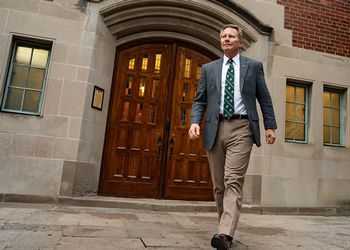Feature: The Rededication of Forest Akers West

THE REDEDICATION OF FOREST AKERS WEST
The championship Forest Akers West golf course, as redesigned by Arthur Hills, has thrust MSU to the national forefront of collegiate golf. The rededication of Forest Akers West golf course on May 24 marked yet another major milestone for Michigan State. The opening of a new championship golf course, re-designed by nationally renown golf architect and alumnus Arthur Hills, immediately puts MSU on the national collegiate golf map. The new course offers a great benefit to student, faculty, staff, alumni and community golfers. It greatly enhances MSU's national prestige and provides another valuable 'crown jewel' in its recruiting arsenal. 'We now have one of the best golf courses--if not the best--in the Big Ten,' notes Ken Horvath, Forest Akers manager and men's golf coach, who received positive feedback during the 1993 Bruce Fossum Spartan Invitational in early May. 'Several coaches told me they like it better than the Scarlet course at Ohio State, which had been considered the best in the league--until now.'
Horvath was motivated by the rejection of MSU as a site for the NCAA championship. 'We were told our former golf course was close, but not acceptable,' he recalls. 'It wasn't the championship caliber they wanted. Now, we are bidding to host the 1994 NCAA women's regional, the 1996 NCAA men's regional, and eventually will shoot to host the NCAA Championships.'
When that day arrives, the nation's best collegiate golfers will face a formidable 7,012-yard challenge in as beautiful a setting as Mother Nature can provide--a veritable arboretum set over rolling hills. The previous flat and squarish look of the course has metamorphosed into one with artistic undulations and a soft, sinewy demeanor. The new contours and mounding flow gently and aesthetically, broken by a tactical sprinkling of grassy craters and moguls.
The bunkering has changed dramatically to better protect the greens, most of them newly elevated and slickened by new United States Golf Association standard bentgrass. None are hidden from view like traffic cops behind billboards. Gone are the awkward blind shots on holes No. 3, 5, 7, 10, 13, 14, 15 and 16, a change that adds more panoramic views while hastening play. The 13th hole, now a par 5, elongates along a swath cut through a thick forest of trees. The 14th hole, a brand new par 3 from stepping-stone tees to a precarious sidehill green, has clearly emerged as the course's signature hole. Those used to cutting the dogleg on No. 10 will find a series of obnoxious moguls in their landing zones, while big hitters will confront massive bunkers guarding the fronts of No. 4 and 9, making the par 5 holes more dangerous to reach in two shots. The blind descent leftwards on No. 15 is no longer blind, the dogleg less sharp, the green lowered. A saddle cut on the No. 7 fairway has given it a gorgeous look from the tee boxes.
'We had a good course, but the improvements have made it magnificent,' says Mary Fossum, MSU's national Hall of Fame women's golf coach. 'We're thrilled. This course forces you to master every club in your bag. If you play well here, then you can play any course anywhere.' The new course boasts a 1990's designer look, with the mounding and other topographical protrusions breaking up the previous flatness. Par has increased by one to 72 (36-36). Every hole has four tee boxes to cater to diverse skill levels. 'We are more of a target course,' he explains. 'We wanted something to test our best golfers. But don't forget, we still have Forest Akers East (for less- skilled golfers).'
One clear demand of the new Forest Akers West is intelligent course management. Hills, the hero of a recent book, Driving the Green (see Spring 1992), emphasizes what he calls 'the strategy of golf shots.' A former MSU varsity golfer, Hills told the MSU Alumni Magazine that his philosophy is to provide golfers with many 'alternate routes, each with different risks and rewards.' 'Arthur Hills had a sincere and personal interest in the project,' says Horvath. 'He genuinely had a desire to help his alma mater. Every weekend during the construction phase he was here like clockwork. He did everything possible to help us keep costs low. As a result,' he continues, 'MSU got far more bang for the dollar than the $1 million cost.'
Some big name architects are known to charge $1 million just to have their names associated with a project. The entire redesign project cost MSU $1 million--'about 80 percent coming from the Forest Akers Trust Fund, the rest from golf course profits, and not one cent from MSU general fund dollars.'
Phil May, trustee of the Forest Akers Trust Fund, clearly played an instrumental role in making it possible. So did Roger Wilkinson, MSU vice president, who Horvath credits with working 'very effectively behind the scenes to muster support for the project.'
Horvath singles out course superintendent Ron Foote as the person mainly responsible for bringing home the project. Foote and his grounds crew managed every cubic inch of the rebuidling project with tender loving care and left no stone unturned to pull it off under budget. 'The job Foote did was tremendous,' says Horvath. 'He was the main man. He was there every day to oversee the construction and defend MSU's interests.'
Many of Foote's contributions, like an improved drainage system, are not be obvious at first sight. But the changes, including the use of new grasses, will greatly affect play. The grass on the tees have been changed from bluegrass to bent for neater presentation. The fairways have been converted to rye grass, which allows for more environmentally-friendly maintenance. Seven new greens boast the slick Pentcross bent grass, while the others combine bent with Poa Annua.
Golfers will find the USGA-grade sand in the new bunkers more consistent and finer than the old 'gravel,' as some used to harrumph. A new cartpath five miles long will make the course playable during wet periods, which tend to recur in East Lansing. 'Give all the credit to my crew,' says Foote, now in his 32nd year at MSU, 22nd as superintendent. 'I have a great group working for me. We're getting there,' he adds. 'A lot of things will take time to finish. But in two years, this will be really something'
'Indeed. The word is 'masterpiece.' Owned and operated solely by MSU, the two Forest Akers courses offer many quality features, including a three-by, heated driving area with year-round practice opportunities for MSU golf teams. The facility is the only college-owned one of its kind in the midwest. In addition, Forest Akers offers a full-service golf shop, practice range, putting green, and lockerroom facilities. Open to students, faculty, staff, alumni and the public, Forest Akers gives a special break to alumni in green fees for 18 holes--$24 on weekdays, $26 on weekends, as opposed to the general fee of $28 and $30. The course is located on the southwest corner of Mt. Hope and Harrison, just east of I-27. The west course was originally designed by MSU alumnus Bruce Matthews, who currently owns and operates the Grand Haven Golf Course.



